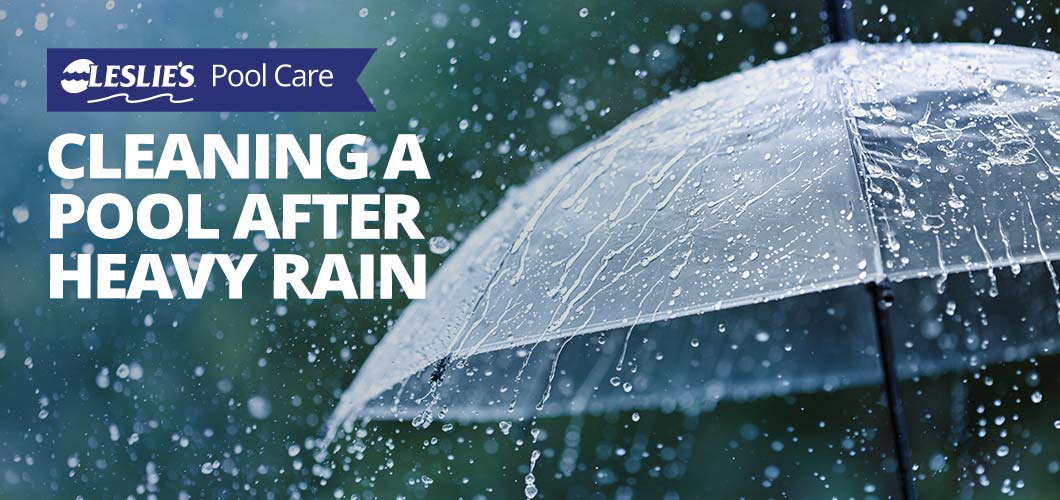
Cleaning a Swimming Pool After Heavy Rain
Heavy rains can overwhelm your pool by significantly altering the chemical balance with the introduction of new water. Storms and flooding can also introduce many other new things into your pool. Dirt, debris, rain water, and even lightning can all affect the overall water chemistry of your pool and put a strain on your equipment. A quick cleanup is essential to minimize potential issues like algae, cloudy water, staining, or excessive filter pressure. The following checklist will help you clean your pool after a rain storm. The main points you need to remember are to:

Skim the pool to remove excess debris.

Test and rebalance pool water. Remove phosphates.

Shock the pool and run the filtration system for at least 12–24 hours.
Items Needed for Rain & Storm Cleanup in Pool
Before you get started, or even as soon as the first sprinkle of rain, make sure you have all the right supplies on hand to maintain your pool water. Once the skies are clear and blue again, it's time to get your water clear and blue again, too.
- Chlorine Pool Shock
- pH and Total Alkalinity Adjusters (Alkalinity Up, Soda Ash, Dry Acid)
- Clarifier (Leslie's Clear Aid or Leslie's Ultra Bright Advanced)
- Phosphate Remover and/or Enzymes (Leslie's Perfect Weekly)
- Stain and Scale Inhibitor (Leslie's Stain and Scale Prevent)
- Pool Test Kit or Test Strips
- Skimmer Net or Leaf Rake
- Pool Brush and Telescoping Pole
- Vacuum Hose
- Manual Vacuum Head or Automatic Pool Cleaner
How To Clean a Swimming Pool After Rain
1. Brush & Skim the Pool
First things first, you'll need to thoroughly skim and brush the pool. Skimming large debris from the pool with a leaf rake alleviates the stress on your filtration system, and stirring up dirt by brushing makes it easier for the system to filter out. Brushing also prevents algae spores and dirt from adhering to pool surfaces. Remember to clean out your skimmer and pump baskets to allow for steady water flow throughout the system.
If there's a lot of dirt and sediment left at the bottom of the pool, remove it manually with a pool vacuum or use an automatic pool cleaner. The cleaner the water is to start with, the more efficiently your sanitizer can work.
BONUS TIP: If heavy rainfall has left your water levels too high, you can remove the excess water with a submersible pump or by turning the multiport valve on your sand or DE filter to the "waste" setting.
2. Test & Balance Pool Water
Test your water with an at-home test kit, or bring a sample to your local Leslie’s for a free AccuBlue® water test. Rain water and other debris affect pool water chemistry, most notably the pH and Total Alkalinity. Be sure to look at Calcium Hardness and metal content, as well. If these numbers fall outside normal ranges, prevent scale and stains from forming by adding a sequestering agent, such as Leslie's Stain and Scale Prevent.
It is also recommended to test for phosphates, as this number typically spikes after a heavy rainfall. This is included with the Leslie's AccuBlue test, or you can use a specialized at-home test kit. A chemical such as Leslie's Perfect Weekly will remove phosphates in the water and starve algae of food, therefore inhibiting its growth. Perfect Weekly also contains enzymes, which break down organic contaminants and help your sanitizer work more efficiently. When using any enzyme product, only add it to the water after your shock treatment, and only once chlorine levels have returned to normal. Otherwise, the enzyme treatment won't work, because the shock will destroy the enzymes.
Lightning increases the nitrogen in the air. Nitrogen is another algae food source, which can lead to grass and algae turning greener. You can keep these photosynthetic organisms in check with shock treatments, which we'll discuss in the next section. It's also a good idea to also add a preventative algaecide, such as Leslie’s Algae Control.
BONUS TIP: No power? No problem! You can either use a battery-operated pool vacuum or a leaf bagger to help keep the water clean and circulating until power is restored. If any equipment was damaged during the storm, you'll find a bunch of helpful tips on our other blog post: How to Maintain a Pool With Damaged Equipment.
3. Shock & Filter the Water
After a hard rain or stormy weather, it's important to shock your pool with a chlorinated shock, such as Leslie's Power Powder Plus or Leslie's Chlor Brite. Shocking helps oxidize any organic contaminants or materials introduced to the water during the storm. The best time to shock is in the evening, so the chlorine doesn't dissipate as quickly as during the day. Chlorine also works most effectively if the water is properly balanced, and pH levels are within the ideal range of 7.4–7.6. Add enough shock to raise FAC levels to 10.0 ppm to oxidize organic contaminants in the water. Allow time for the shock to work, and for chlorine levels to drop back down to 2.0–4.0 ppm before swimming again.
Run your system for at least 12–24 hours to ensure proper filtration and circulation. This removes dirt and debris, and also assists in circulating the chlorine throughout your pool. The day after shocking the pool, check the PSI on your filter pressure gauge. When the pressure is 8–10 PSI higher than the clean or starting pressure, you'll need to clean the filter.
If your pool water is still cloudy after balancing the pool, shocking your water, and running your filter, you can add a water clarifier like Leslie’s Ultra Bright Advanced or Leslie's Clear Aid to help expedite the cleaning process.
If any questions or problems arise, stop in to chat with your local Leslie’s pool specialist to help you clean your pool after a rain storm. Our team is standing by to answer all your pool care questions.